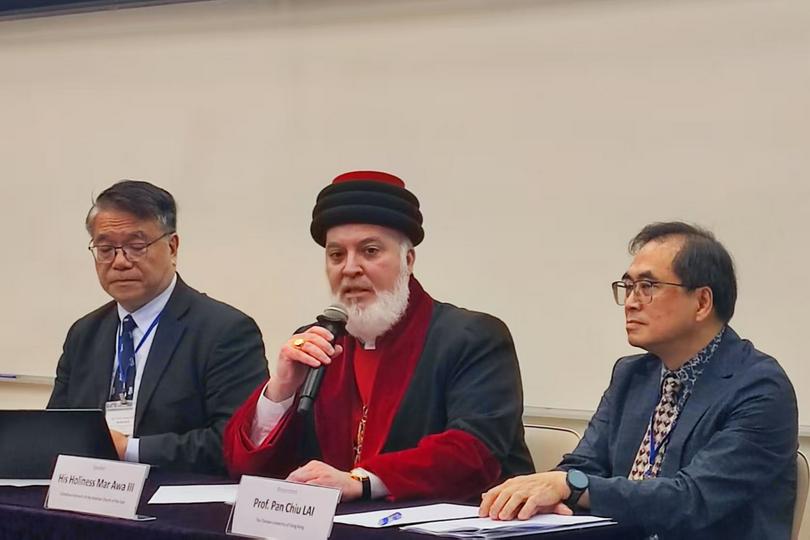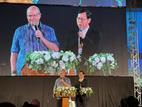On October 17, 2025, His Holiness Mar Awa III, Catholicos-Patriarch of the Assyrian Church of the East, delivered a lecture titled "Reception of the Nicene Creed in the Assyrian Church of the East" at the Yasumoto International Academic Park of The Chinese University of Hong Kong (CUHK).
The academic exchange, chaired by Prof. Joshua Cho of Hong Kong Baptist Theological Seminary, was jointly organized by the Institute of Sino-Christian Studies, which is celebrating its 30th anniversary, the Divinity School of Chung Chi College, and the Center for Christian Studies at CUHK.
In his lecture, His Holiness Mar Awa III provided a detailed account of the unique journey of the Nicene Creed within the Assyrian Church of the East, a community situated outside the Roman Empire's borders. He began by setting the historical context of the Council of Nicaea in 325 AD, which formulated the creed to counter the teaching that Christ was not fully divine. The council's central declaration rested on the Greek term homoousios, meaning the Son shares the same divine "substance" or "essence" as the Father.
His Holiness's lecture then unfolded a compelling narrative of a dynamic, two-stage reception history, demonstrating how the creed was not passively accepted but actively reinterpreted.
In the first stage, around 410 AD, the creed was introduced to the church in the Persian Empire. The primary challenge was translating the philosophically-charged Greek term homoousios into Syriac. The solution adopted was the phrase bar-ītūtā, literally meaning "son of the essence." His Holiness emphasized that this initial translation was a direct and faithful response to Nicaea's original purpose: it focused squarely on the concept of "being" or "essence" to affirm that the Son originates from the Father's fundamental being, thus securing His full divinity.
In the second stage, after the great Christological controversies of the 5th century, the debate shifted from the Trinity to how Christ's divine and human natures coexist. His Holiness detailed how this new climate led to a significant evolution in the creed's interpretation. By a major synod in 586 AD, the standard Syriac rendering of homoousios had changed to bar-kyānā, literally meaning "son of the nature."
The core of His Holiness's argument was that this linguistic shift was not a simple translation choice, but a profound theological act. It served as a "theological thermometer," reflecting the church's evolving priorities. The Assyrian Church was, in effect, rereading the older Nicene Creed through the lens of the more recent Christological debates. By adopting the term "nature" (kyānā)—the key vocabulary of these later controversies—the church infused the creed with new meaning. The emphasis shifted from a purely Trinitarian statement about the Son's relationship to the Father to a statement with strong Christological undertones about the Son's divine nature.
This process, he concluded, is a prime example of theological "reception," demonstrating that the creed was not a static fossil but a living document, dynamically interpreted to address the most pressing questions of a local church's intellectual and spiritual life. This analysis directly challenges the stereotype of the Assyrian Church as a rigid or isolated entity, revealing it instead as a community of active and sophisticated theological thinkers.
Following the lecture, Prof. Pan Chiu Lai of The Chinese University of Hong Kong offered a response that mirrored this theme of creative interpretation. Prof. Lai drew a parallel between the complexities of translating homoousios into Syriac and the similar challenges in Chinese. He argued that contemporary application is more critical than a single, perfect translation, highlighting a Chinese scholar who creatively integrated the concept of Christ as the "firstborn of all creation" into the creed's framework. This, he suggested, opens avenues for dialogues with Confucianism and informs an ecological mission for the church.
The subsequent question-and-answer session addressed several key theological issues. In response to a question about the authority of ecumenical councils, His Holiness clarified that the Assyrian Church historically focused on accepting the doctrine of the creeds and canons rather than the political structures of the councils. He stated that while his church does not formally accept councils after the First Council of Constantinople, it has not condemned them, leaving room for dialogue on the doctrine behind the formulas. He identified the matter of primacy as a key issue for future ecumenical unity.
When another questioner raised the issue of importing Greek theological terms with "Roman baggage," His Holiness described this as an "ecumenical opening" following a period of persecution, while affirming the strength of the native Semitic and biblical theological tradition. He also emphasized that language is a limited medium for defining divine mysteries and that ecumenical progress is better served by simple, shared statements of faith, such as the 1994 Common Christological Declaration. This point was amplified by a critical reflection from Prof. Lai, who introduced the concept of "doctrinal inflation." He cautioned against the historical tendency to add ever more layers of technical definitions, which, like adding endless digits to pi, can sometimes obscure rather than illuminate the core faith.
Finally, when asked about the Holy Spirit, His Holiness explained that the Assyrian understanding is primarily liturgical, rooted in the Eucharistic prayer of epiclesis (invocation of the Spirit), and consistently emphasizes the Father as the sole source of the Trinity, avoiding excessive speculation on the inner-Trinitarian life.












